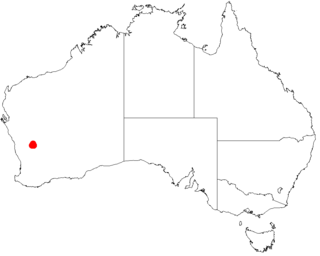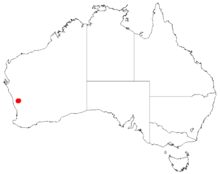Acacia kingiana was a species of wattle that occurred in an area north east of Wagin in the Avon Wheatbelt region of south-west Western Australia. It has been declared extinct under Australia's Environment Protection and Biodiversity Conservation Act 1999, and Western Australia's Wildlife Conservation Act 1950.

Grevillea asparagoides is a species of flowering plant in the family Proteaceae and is endemic to the south-west of Western Australia. It is dense, prickly shrub with deeply divided leaves, the end lobes linear and sharply pointed, and pink to reddish flowers with red styles.

Acacia brachypoda, known colloquially as western wheatbelt wattle or Chinocup wattle, is an endangered species of Acacia restricted to a small locality in western Australia's wheatbelt.

Grevillea dryandroides, commonly known as phalanx grevillea, is a species of flowering plant in the family Proteaceae and is endemic to the south-west of Western Australia. A diffuse, clumping shrub, it often forms suckers and has divided leaves with up to 35 pairs of leaflets, and groups of red to pinkish flowers on an unusually long, trailing peduncle.

Grevillea christineae, commonly known as Christine's grevillea, is a species of flowering plant in the family Proteaceae and is endemic to the south-west of Western Australia. It is an erect, rounded shrub with wiry branches, linear to narrowly elliptic leaves, and white flowers.

Eucalyptus rhodantha, commonly known as rose mallee or rose gum, is a species of straggly mallee or shrub native to parts of Western Australia. It has smooth bark and a crown composed entirely of circular to heart-shaped juvenile leaves arranged in opposite pairs and attached directly to the stems with no stalks. The flower buds appear singly in the leaf axils and are red, the fruits hemispherical to conical and pendent. The rose mallee is grown as an ornamental shrub suitable for gardens in hot and dry climates. It is found more often in urban gardens and cultivation than in the wild and is readily available in seed form.

Acacia anomala, commonly known as grass wattle is a shrub belonging to the genus Acacia. It is native to a small area along the west coast of Western Australia, and is listed as a vulnerable species under the Western Australian Wildlife Conservation Act and the Commonwealth Environmental Protection Act.

Acacia ataxiphylla, commonly known as the large-fruited Tammin wattle, is a shrub belonging to the genus Acacia. It is native to Western Australia.

Acacia forrestiana, commonly known as Forrest's wattle, is a shrub belonging to the genus Acacia and the subgenus Phyllodineae that is native to Western Australia. The species was listed as vulnerable by the Environment Protection and Biodiversity Conservation Act 1999 in 2008.

Acacia imitans, also commonly known as Gibson wattle, is a shrub belonging to the genus Acacia and the subgenus Phyllodineae that is endemic to south western Australia. It is a declared endangered species under the West Australian and Australian Acts, and is on the IUCN Redlist.

Acacia vassalii, commonly known as Vassal's wattle, is a shrub of the genus Acacia and the subgenus Phyllodineae that is endemic to a small area of south western Australia. It is listed as critically endangered with the World Conservation Union, as endangered according to the Environment Protection and Biodiversity Conservation Act 1999 and as rare flora with the Wildlife Conservation Act 1950 in Western Australia.

Acacia auratiflora, commonly known as the orange-flowered wattle, is a shrub of the genus Acacia and the subgenus Plurinerves. It is listed as an endangered species.

Acacia caesariata is a shrub of the genus Acacia and the subgenus Plurinerves. It is native to an area in the Wheatbelt region of Western Australia.

Acacia lobulata, commonly known as Chiddarcooping wattle, is a shrub of the genus Acacia and the subgenus Plurinerves that is endemic to a small area of south western Australia. It was declared as rare flora in 1997 and is now listed as endangered under the Environment Protection and Biodiversity Conservation Act 1999.

Acacia pharangites, commonly known as Wongan gully wattle, is a shrub of the genus Acacia and the subgenus Plurinerves that is endemic to the Wongan Hills of south western Australia and is listed as endangered according to the Environment Protection and Biodiversity Conservation Act 1999.

Acacia sciophanes, commonly known as the Ghost wattle or Wundowlin wattle, is a shrub of the genus Acacia and the subgenus Plurinerves that is endemic to a small area in south western Australia. In 1995 it was declared as rare in 1995 according to the Western Australian Wildlife Conservation Act 1950 and is listed as endangered under the Environment Protection and Biodiversity Conservation Act 1999.

Acacia wilsonii, also known as Wilson's wattle, is a shrub of the genus Acacia and the subgenus Plurinerves that is endemic to a small area of western Australia. It was listed as an endangered species in 2018 according to the Environment Protection and Biodiversity Conservation Act 1999 by Australian authorities and according to Biodiversity Conservation Act 2016 by Western Australian authorities.

Acacia depressa, also commonly known as echidna wattle, is a shrub of the genus Acacia and the subgenus Pulchellae that is endemic to south western Australia. It was listed as vulnerable according the Environment Protection and Biodiversity Conservation Act 1999 in 2007.
Verticordia hughanii, commonly known as Hughan's featherflower, is a flowering plant in the myrtle family, Myrtaceae and is endemic to the south-west of Western Australia. It is a small shrub with spreading, oblong leaves and spike-like groups of bright red flowers near the ends of the branches. It is a rare plant, only known from three small populations and currently meets the requirements of the World Conservation Union Red List Category "Endangered".
Acacia equisetifolia is a small shrub in the genus Acacia. It is endemic the Northern Territory, and is critically endangered under the Commonwealth Environment Protection and Biodiversity Conservation Act 1999, being known only from Graveside Gorge in the Kakadu National Park, where it grows on sandstone slopes and ledges at the tops of sheer cliffs. It flowers in February, with near-mature pods observed as being present in March, August and October.


















